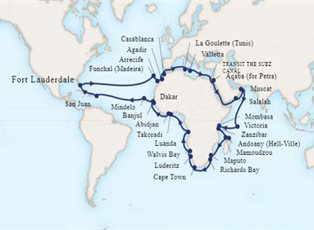
Journey
74 Night Cruise sailing return from Ft Lauderdale onboard Amsterdam.
Departure Date
8 Oct 2020
-
Itinerary
Cruise Itinerary
-
- Day
- Date
- Port
- Arrive
- Depart
-
- Day:Day 1
- Date:8 Oct 20
- Port:Ft Lauderdale (Pt Everglades), USA
- Arrive:
- Depart:04:00 PM
-
- Day:Day 9
- Date:16 Oct 20
- Port:Funchal (Madeira), Portugal
- Arrive:08:00 AM
- Depart:05:00 PM
-
- Day:Day 10
- Date:17 Oct 20
- Port:Arrecife, Lanzarote, Canary Islands, Spain
- Arrive:12:00 PM
- Depart:06:00 PM
-
- Day:Day 11
- Date:18 Oct 20
- Port:Agadir, Morocco
- Arrive:07:00 AM
- Depart:01:00 PM
-
- Day:Day 12
- Date:19 Oct 20
- Port:Casablanca, Morocco
- Arrive:07:00 AM
- Depart:07:00 PM
-
- Day:Day 15
- Date:22 Oct 20
- Port:La Goulette, Tunisia
- Arrive:07:00 AM
- Depart:05:00 PM
-
- Day:Day 16
- Date:23 Oct 20
- Port:Valletta, Malta
- Arrive:10:00 AM
- Depart:06:00 PM
-
- Day:Day 19
- Date:26 Oct 20
- Port:Suez Canal
- Arrive:Transit
- Depart:
-
- Day:Day 21
- Date:28 Oct 20
- Port:Aqaba, Jordan
- Arrive:07:00 AM
- Depart:overnight
-
- Day:Day 22
- Date:29 Oct 20
- Port:Aqaba, Jordan
- Arrive:
- Depart:05:00 PM
-
- Day:Day 27
- Date:3 Nov 20
- Port:Salalah, Oman
- Arrive:07:00 AM
- Depart:05:00 PM
-
- Day:Day 31
- Date:7 Nov 20
- Port:Equator Crossing
- Arrive:
- Depart:
-
- Day:Day 32
- Date:8 Nov 20
- Port:Victoria, Mahe, Seychelles
- Arrive:08:00 AM
- Depart:overnight
-
- Day:Day 33
- Date:9 Nov 20
- Port:Victoria, Mahe, Seychelles
- Arrive:
- Depart:05:00 PM
-
- Day:Day 36
- Date:12 Nov 20
- Port:Mombasa, Kenya
- Arrive:08:00 AM
- Depart:overnight
-
- Day:Day 37
- Date:13 Nov 20
- Port:Mombasa, Kenya
- Arrive:
- Depart:05:00 PM
-
- Day:Day 38
- Date:14 Nov 20
- Port:Zanzibar, Tanzania
- Arrive:08:00 AM
- Depart:05:00 PM
-
- Day:Day 40
- Date:16 Nov 20
- Port:Mayotte, Comoro Islands
- Arrive:08:00 AM
- Depart:05:00 PM
-
- Day:Day 41
- Date:17 Nov 20
- Port:Nosy Be, Madagascar
- Arrive:07:00 AM
- Depart:03:00 PM
-
- Day:Day 44
- Date:20 Nov 20
- Port:Maputo, Mozambique
- Arrive:08:00 AM
- Depart:05:00 PM
-
- Day:Day 45
- Date:21 Nov 20
- Port:Richards Bay, South Africa
- Arrive:08:00 AM
- Depart:11:00 PM
-
- Day:Day 48
- Date:24 Nov 20
- Port:Cape Town, South Africa
- Arrive:08:00 AM
- Depart:overnight
-
- Day:Day 49
- Date:25 Nov 20
- Port:Cape Town, South Africa
- Arrive:
- Depart:11:00 PM
-
- Day:Day 51
- Date:27 Nov 20
- Port:Luederitz, Southern Namibia
- Arrive:08:00 AM
- Depart:05:00 PM
-
- Day:Day 52
- Date:28 Nov 20
- Port:Walvis Bay, Namibia
- Arrive:10:00 AM
- Depart:11:00 PM
-
- Day:Day 55
- Date:1 Dec 20
- Port:Luanda, Angola
- Arrive:07:00 AM
- Depart:05:00 PM
-
- Day:Day 57
- Date:3 Dec 20
- Port:Equator Crossing
- Arrive:
- Depart:
-
- Day:Day 59
- Date:5 Dec 20
- Port:Takoradi, Ghana
- Arrive:08:00 AM
- Depart:05:00 PM
-
- Day:Day 60
- Date:6 Dec 20
- Port:Abidjan, Ivory Coast
- Arrive:08:00 AM
- Depart:05:00 PM
-
- Day:Day 63
- Date:9 Dec 20
- Port:Banjul, Gambia
- Arrive:08:00 AM
- Depart:05:00 PM
-
- Day:Day 64
- Date:10 Dec 20
- Port:Dakar, Senegal
- Arrive:08:00 AM
- Depart:05:00 PM
-
- Day:Day 66
- Date:12 Dec 20
- Port:Mindelo (Porto Grande) Sao Vicente, Cape Verde Islands
- Arrive:08:00 AM
- Depart:05:00 PM
-
- Day:Day 72
- Date:18 Dec 20
- Port:San Juan, Puerto Rico
- Arrive:08:00 AM
- Depart:11:00 PM
-
- Day:Day 75
- Date:21 Dec 20
- Port:Ft Lauderdale (Pt Everglades), USA
- Arrive:07:00 AM
- Depart:
** Itinerary may vary by sailing date -
-
Your cruise in detail
74 Night Cruise sailing return from Ft Lauderdale onboard Amsterdam.
The third Holland America Line vessel to bear the name Amsterdam, this elegant, mid-sized ship features a three-story atrium graced by a stunning astrolabe. While on board, enjoy America’s Test Kitchen cooking shows and hands-on workshops. Thrill to our exclusive BBC Earth Experiences presentations and activities. Rejuvenate at the Greenhouse Spa & Salon. Work out at our Fitness Center. And savor our delectable array of specialty restaurants.
Highlights of this cruise:
Ft Lauderdale, Florida, US
Shimmering blue waters, swaying palm trees and soft ocean breezes greet you in Ft. Lauderdale, Florida, where you'll find yourself somewhere between laid-back island time and the fast pace of a thriving city. In this sun-filled, year-round beach town, pristine beaches are the main attraction, shorts and flip-flops are the daily uniform, and yachts are often the preferred form of transportation. It's a place where you can do as much, or as little, as you desire. Because of its many canals and waterways, Ft. Lauderdale is sometimes called the Venice of America. It's home to the annual Fort Lauderdale International Boat Show, one of the largest in-water boat shows in the world. Visitors can easily get a taste of the area's nautical lifestyle by cruising the Intracoastal Waterway on an old-fashioned paddle wheeler. Other options include hopping aboard one of the popular water taxis or Venetian gondolas that glide down the historic New River, which flows right through town. While Ft. Lauderdale is often overshadowed by its flashy neighbor, Miami, the port city is expanding rapidly as major developers and high-end resorts build up the beachfront and surrounding neighborhoods. Visitors will find world-class shopping on famous Las Olas Boulevard, celebrated restaurants and a cultural explosion in the Riverwalk Arts & Entertainment District. It's clear that Ft. Lauderdale is solidifying its place as a sophisticated destination.
Funchal (Madeira), Portugal
When Portuguese navigators set foot on the island of Madeira in 1419, they were convinced that they had arrived at the Garden of Eden. Today, the experience is no different for cruise passengers docking in Funchal, Madeira’s largest city and the capital of a namesake autonomous region. Madeira’s consistently warm weather and volcanic mountains lush with tropical flowers and gardens drew European settlers whose influence gave rise to much of what it’s known for: Madeira wine, poncha (a traditional drink made of distilled sugarcane, honey and lemon) and handiwork such as embroidery. Wander cosmopolitan Funchal’s streets paved with black and white mosaics, a grand seafront promenade and old-fashioned shops, restaurants and cafés housed in terra-cotta-roofed buildings. Although the majority of places of interest are close to the Atlantic Ocean’s pebbled shore, some of the city’s most worthwhile attractions are situated above sea level; take a cable car to the peaks that rise over the harbor for a bird’s-eye perspective of an island as much a paradise from above as it is from below.
Agadir, Morocco
Regardless of when you visit Agadir, on Morocco’s Atlantic Coast, your chances of arriving on a sunny day are pretty high. That selling point has made it a popular seaside resort for Europeans, who stroll along the promenade and surf, wet bike and ride camels on the seemingly endless crescent-shaped beach. Here, you can sip a cup of Berber tea at a café, grab a pint at a pub or dine and dance at one of the beach clubs. Beyond the beach, much of the area’s history has been erased, and all that can be seen today are modern whitewashed buildings and palm-lined boulevards. (Though it was the site of an ancient Roman port and occupied by both the French and the Portuguese, Agadir was almost completely destroyed by an earthquake in 1960 and little of its past survived.) You can still explore the region’s heritage at the Amazigh Museum, which provides an introduction to Berber culture, and the hilltop casbah, built in the 16th century. Don’t miss the souks, with local products like saffron, olive oil, dates and Berber handicrafts, including silver jewelry, handmade slippers, carpets and pottery. Outside Agadir, red-walled towns and valleys with limestone canyons and waterfalls await.
Valletta, Malta
The ancient city of Valletta is teeming with historic monuments, churches and gardens. At just one-third of a square mile in area, Europe's southernmost capital is one of the easiest to explore on foot. Given Malta's strategic location and succession of rulers including the Romans, Normans, Sicilians, Spanish, Knights of St. John, French and British, it’s somewhat surprising to see Valletta so well preserved. The city dates back to the 16th century and has been listed as a UNESCO World Heritage Site since 1980. Extensive restorations of historic buildings are underway, including the rebuilding of the city entrance to mark Valletta's recognition as the European Capital of Culture in 2018. Decades of British rule mean that English remains an official language, along with the local Maltese language, plus a curious mix of Italian vocabulary and Semitic roots. As Malta lies just 50 miles south of Sicily, Italian influences dominate the cuisine and culture. Even so, the Maltese do value their own traditions, such as the folk music known as Għana, which features strong yet poetic male vocals over slow guitar music.
Aqaba (For Petra), Jordan
Jordan may appear at first glance like a vast, empty land, but its territory has been inhabited for 6,000 years and it is home to an enormous number of historic sites and natural wonders. Most of them are easily accessible just off of the King’s Highway, which stretches from the capital, Amman, down to Aqaba on the Red Sea. As the country’s only port, Aqaba has long been linked to the legend of Lawrence of Arabia, or T.E. Lawrence, and to the famous 1962 film by Sir David Lean. The massive Aqaba flagpole is, at 131 meters (430 feet), one of the tallest in the world and commemorates the Great Arab Revolt of 1916 against the Ottoman Empire in which Lawrence played a key role. Aqaba is a decidedly quieter place now than in the heyday of revolt, whether one comes for the deepwater dive spots, duty-free shopping or its new high-end residential and resort district. Old Aqaba, with a fort that dates from the era of Christian crusaders, continues to be a wonderfully atmospheric neighborhood. There, after a long day in the desert heat, visitors can seek out a Turkish bath for a massage and scrub or take a break from exploring at any number of cafés that overlook the port.
Salalah, Oman
Tucked between the Dhofar Mountains and the Arabian Sea, subtropical Salalah is the gateway to Southern Oman’s pristine white-sand beaches, dramatic natural beauty and ancient frankincense-trade routes. Each year from July to September, the rains of the khareef, a monsoon that blows in from the Indian Ocean, transform the Dhofar region’s stark desert vistas into lush oases dotted with seasonal waterfalls and grazing camels. Enjoy a scenic drive through these misty-green peaks and wadis, worlds away from the bone-dry Omani heartland to the north. Spend an afternoon strolling under coconut palms and frankincense trees on one of Salālah’s hidden beaches. Follow in the footsteps of famed travelers like Ibn Battutah, Marco Polo and the Queen of Sheba at the region’s four \"Land of Frankincense\" UNESCO World Heritage Sites. These waterfront archaeological parks bear witness to a rich history of traffic in incense and spices dating back to the Neolithic period. Merchants from all over the world once swarmed Salālah’s ports and markets. Today, the city retains its identity as a crossroads for cultures, climates and landscapes. A journey through Salalah’s tropical-fruit plantations and bustling souks will transport you from the Arabian Desert to Zanzibar, India and beyond.
Victoria, Mahe, Seychelles
The Seychelles, a group of 115 islands in the Indian Ocean about 1,000 miles off the east coast of Africa, impresses visitors with its pristine natural beauty and indigenous plants and animals, such as the hawksbill turtle and the magpie robin. On the island of Mahé, Victoria—the nation’s main city and one of the smallest capitals in the world—bustles with activity and is home to nearly a third of the Seychelles’ population. Set against steep, velvet-green mountains that include 905-meter (3,000-foot) Morne Seychellois, the island's highest peak, the city is a colorful patchwork of tin-roofed buildings. It displays a vibrant Creole heritage that’s evident in the conversations of locals (English is the official language, but Seychellois Creole is the lingua franca) and the aroma of fragrant spices wafting from its open-air market. Beyond the market area, Victoria’s main sights are the circa 1903 Victorian clock tower Little Ben, modeled after its larger counterpart in London, and the Arul Mihu Navasakthi Vinayagar temple, the only Hindu temple on the islands. Just outside of town is the tranquil Seychelles National Botanical Gardens, but to truly appreciate Mahé Island, one must head to the beach—and luckily there are more than 60 from which to choose.
Mombasa, Kenya
Vibrant Mombasa lies on the coast, home to white sand beaches and coral reefs teeming with tropical sea life. The remains of Fort Jesus stand out from the harbor and are home to a small historic museum. Get a taste of local Swahili village traditions in Mombasa's Old Town, where narrow streets and curio shops beckon. Buildings here are based on ancient designs and feature intricate carvings and detailed lattice work. In the modern center, stroll Moi Avenue for a souvenir, and discover the city's famous ceremonial arch. Nearby, the Shimba Hills National Reserve is home to the rare endangered sable antelope. Adventurers can head to Mamba Village in Nyali, East Africa's largest crocodile farm.
Maputo, Mozambique
Mozambique's capital and largest city, Maputo, has finally recovered from a 15-year civil war that ended in 1992, and is now bounding toward prosperity, thanks to one of Africa’s fastest-growing economies. For curious travelers, there's much to discover here: You'll find a fascinating swirl of cultures—including Portuguese, Bantu, Arab, Chinese and Indian—and be energized by the lively atmosphere of a young, vibrant Africa on the move. Recent investments in Maputo’s parks and museums as well as in the historic Baixa quarter have put a new shine on much of the city. A good place to start your exploration of the two main neighborhoods, uptown and Baixa, is Independence Square, the gateway to both areas. Here, architectural styles mix to surprising effect. Next, head to the central market in Baixa, the historic heart of town, for a glimpse of residents' daily life and to visit some of the cultural highlights such as the National Money Museum, housed in one of Maputo's oldest buildings. Don’t miss the beautiful gardens at the Natural History Museum, the elegant old train station and the underappreciated modernist architecture dating from when Mozambique was ruled by Portugal. Maputo consistently delivers surprises like these—and more.
Cape Town, South Africa
Cape Town's spectacular setting on Table Bay, beneath the 1,082-meter (3,550-foot) Table Mountain and Lion's Head, seldom fails to take one's breath away, whether you are a local or a visitor. If Johannesburg is South Africa's New York, this port city of four million, settled by traders from the Dutch East India Company in 1652, is its San Francisco. With a rich array of restaurants, galleries, vineyards and countless beaches, as well as a Mediterranean climate, life on the Cape Peninsula, which stretches for some 70 kilometers (43 miles) from downtown to the most southerly point, Cape Point, is genteel and all about good, healthy living and staying outdoors as much as possible. The Table Bay side of the city, known for its luxurious seaview properties and bustling nightlife, is countered by equally intriguing False Bay, which lies behind Table Mountain and is home to quaint, cobblestoned fishing villages like Kalk Bay, as well as the city's famous penguin colony. There, too, you'll find the oldest (and some of the best) vineyards in Africa, such as Constantia Uitsig and Buitenverwachting. If you visit, though, be warned: Once might not be enough.
Luanda, Angola
On the west coast of southern Africa, Luanda, the capital of Angola, has seen its share of strife, but today it is a rising economic powerhouse. Founded by the Portuguese in 1576, the city struggled through decades of conflict—a war of independence followed by a civil war—before embarking on a renaissance fueled by oil and diamonds. Today, there’s a jolting divide between the haves and the have-nots, with ostentatious displays of wealth among pockets of poverty. Your first encounter with the city will likely take place on the Marginal, a commercial promenade with a jumble of modern high-rises, Soviet-style blocks and colonial houses, which runs along the bay. Highlights of Luanda include the 16th-century Fortress of São Miguel, which houses the Museum of the Armed Forces and has panoramic views. Nearby, the pink National Bank of Angola is a beautiful example of Portuguese colonial architecture, and the Agostinho Neto Mausoleum, whose 120-meter (393-foot) height dominates the skyline, contains the remains of the first president of Angola. Have lunch at one of the chic restaurants on the Ilha de Luanda—preferably under a palm tree. This sandy spot just across the bay from Luanda attracts the city’s newly wealthy crowds and caters to their expensive tastes.
Dakar, Senegal
Alluring and frenetic, Senegal’s capital, Dakar, was long a tiny settlement on the southern part of the Cape Verde peninsula. It now encompasses former colonial towns (it was once a French commune) and a handful of other villages. The hub is the Place de l’Indépendance, a buzzing square lined with both concrete-block and colonial buildings and from which streets with restaurants, shops and theaters radiate. Roads are often congested with buses, taxis and horse-drawn carriages, and the Medina quarter, home to the Grand Mosque and markets, is an explosion of color and commotion. The food scene has a lot of flavor, too, with influences from Senegal’s many ethnic groups, European past, and a large Lebanese expat community. Alongside trendy restaurants, you’ll find beachside night markets and traditional spots serving thieboudienne (seasoned fish served with rice and vegetables). Music makes up much of the pulse of Dakar—you'll hear the drumbeats of the local mbalax music emanating from the city's dance clubs—but there are more serene parts of Dakar, too. The streets of Île de Gorée, once a depot for the slave trade, can be hauntingly quiet, and an hour away, the pink-tinted Lake Retba offers a respite from Dakar’s never-ending sights and sounds.
Mindelo, Cape Verde
There’s something wonderful about visiting a place many people have barely heard of and would have trouble pinpointing on a map. Okay, maybe the Weather Channel fans might recognize the Cape Verde Islands (officially, the Republic of Cabo Verde) as the place where many Atlantic hurricanes form, but this volcanic 10-island archipelago located 500 kilometers (310 miles) off the northwestern coast of Africa is more prone to drought than tropical deluges. The arid, mountainous landscape, fringed by beaches, is home to about 500,000 people. The archipelago was a Portuguese colony from 1495 until achieving independence in 1975, and Mindelo is the capital of one of the northernmost islands, São Vicente. With its rich Portuguese-Creole-African culture, this city is the nation’s musical epicenter, and morna—an appealing fusion of Portuguese and African rhythms—is the signature sound. Mindelo's cobblestoned streets are lined with music clubs and bars, and several lively festivals take place here throughout the year. Colorful colonial-style buildings surround the deep-blue harbor, along which you’ll find a small-scale reproduction of Lisbon’s landmark Tower of Belém.
San Juan, Puerto Rico
Take a stroll along and then past the old city walls and explore the colorful cobblestone streets of old San Juan – a UNESCO World Heritage Site and National Historic Site within the U.S. National Park Service. Taste your way through the city’s extraordinary culinary scene, immerse yourself in its colorful history, or just pull up at a beach and grab a local rum cocktail. Welcome to San Juan. -
Travel dates
-
- Departing
- From
- Price From
-
Information on this website has been obtained from the various Cruise Companies represented, however as the cruise industry is constantly changing and this information should be used as a guide only. We are unable to take responsibility for incorrect information and you must confirm all details the time of booking. Offer subject to availability at time of booking. Prices are per person share twin based on best available cruise fare, inclusive of all discounts unless otherwise stated. Where suite pricing is indicated this will be for lead in suite accommodation only and may in some cases be for a mini suite, which is the lead in suite category. Please ask for clarification at time of enquiry. Prices are subject to currency fluctuations and are based on cash or cheque. Cruise deposit, amendment and cancellation conditions apply. Travel agent service fees may apply. Special conditions apply - please ask for full details at time of enquiry.












